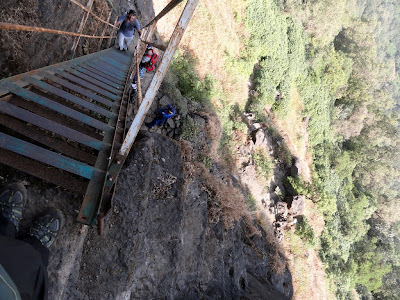Salher, Salota, Mulher, and Mora belong to the Baglan region of Sahyadris. This area has experienced vibrant and intense moments in history. The famous Battle of Salher (1671-72 AD) took place near Salher fort. This major battle was probably the only battle that Shivaji fought on open ground against the Mughals. (Most of his battles involved sneaking up on the enemy and taking them by surprise.) The forts do have remnants of their original splendour albeit in a dilapidated manner. If you allow your imagination to soar, you can build up a splendid and vivid picture of what these forts would have been in their glory. I wish our leaders or institutes would have spent some money to maintain such monuments from the past.
Day 0 - Pune-Waghambe
We started from Pune to Waghambe village that is just before Salherwadi, the base village for Salher fort. The journey was quite long and we reached at around 7:30 AM at the base. After a quick breakfast, we started the climb for Salher.
Day 1 - Salher-Salota
The plan was to climb Salher and Salota and reach the Waghambe village by evening. We started at around 9:30 AM for Salher. The climb though not difficult, is on a continous incline.
 |
| Salher fort from Salherwadi |
 |
| You can see the incline |
 |
| Towards the Parshuram Temple |
 |
| Nearest mountain is Salota |
 |
| Salota on the left while traversing Salher |
 |
| Salher to Salota - route map |
 |
| Onwards the ridge to Salota |
 |
| Salota and it's rock-cut steps |
 |
| Salher as seen from Salota |
From the top of Salota, we again descended to the ridge connecting Salher-Salota and from this point, we started walking towards the base village of Waghambe. It was quite a long walk and by the time we reached the village, we had to use torches as it became dark after sunset. At Waghambe village, our bus was waiting to take us to Mulherwadi, the base village for Mulher, where we planned to stay overnight. We stayed in an ashram overnight and ate at a locals place.
Day 2 - Mulher-Mora
After an early morning breakfast, we resumed day 2 of our trek. I was worried that the long walk and climb that we did for Salher and Salota would cause some muscle ache on Day 2, but the deep overnight sleep and limbering up done in the morning sun proved to be rather good.
Mulher trek starts from Mulherwadi. All along the trek, we could see the steep peaks of Mangi - Tungi right opposite Mulher.
After the initial walk traversing around the fort through shrubs and grasses, we reach the beautiful Ganesh temple.
 |
| Ganesh temple en route Mulher. Hargad in the background. |
The climb towards the top of Mulher is across a beautiful route that goes zig-zag between walls built to stop the enemy.
It is incredible to see the old structures standing the test of time and nature. Then again, you can stop and wonder about the erstwhile original structure and be completely impressed.
 |
| Reaching the top of Mulher |
 |
| Mulher on left, Mora on right - route map |
 |
| The stone steps leading to the top of Mora |
This was a memorable trek, and very different from the nearby ranges in Pune. The mountains in the Baglan region are steep and most of them have a prominent cliff peaking on top. I’ll remember this most for the wonderful traverses that were challenging for the body and mind.




































